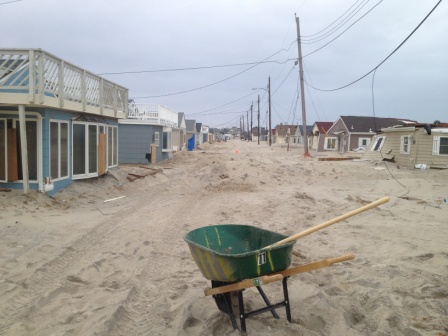After the Flood
By: Sean Fleming

It was easy to complain about the mold. There was nothing good to say about it, and for weeks our crew had stared at little else. Last December, I was part of the third Conservation Corps of Minnesota Hurricane Sandy Deployment. Our primary work involved going into flooded houses and gutting the moldy sheet-rock and insulation. The mold soaked our gloves, it stunk up our clothes, and it seemed to never end, growing worse by the day. But we worked at the mold, house after house, block after block for eight hours a day, six days a week, for a month.
Stories of incredible human resilience displayed during the storm inspired me throughout the weeks. A man spent the entire storm outside in waders with a ten-foot pole deflecting boats, cars and floating sections of destroyed houses from his trailer-home. Some stories were tragic: the surfer Dylan Smith, who rescued six people in the Rockaways using his surf board and a make-shift raft, who drowned on December 23 surfing in Puerto Rico. Some romantic: the couple who boarded up their house and laid in bed watching the waves roll in. And some comical—the man who told us he had just finished packing his belongings after the evacuation notice, and decided to catch a football game on TV. The game lulled him to sleep, and when he woke up in his flooded house, he called the National Guard which sent a tank out to rescue him. When he returned to the island, his car had stayed completely dry—the only car left on the island that still ran.
People told us their stories. They baked us food. They brought us into their homes for Thanksgiving and Christmas. They gave us haircuts. The locals that had remained on the island became our family. Disaster relief work consumes your life. The work is endless, but there is nothing else to do. The island is empty, but there is no where else to go. Without you, it seems, nothing will work.
But after four weeks, that endless work slowed to a trickle on Long Beach Island. The contractor trucks that had congested the streets disappeared; the debris piles that blockaded the sidewalks vanished. When we arrived, the island had looked like the set of a Godzilla film, and when we left, it looked eerily normal.
For the last two days of our deployment we drove to the island of Seaside Heights to shovel out houses. Even after a month of working on Long beach island, I stood speechless before the destruction at Seaside Heights. We were instructed to dig trenches to the doorways of destroyed houses so that homeowners could remove any possessions from their homes before the National Guard bulldozed the neighborhoods. Freezing rain sealed the sand and numbed our hands, but any work outdoors was a nice break from the mold. The shovel blades bounced off the sand, and we laughed, grateful to not be laughing through a respirator. It’s hard to leave a place where everyone calls you a hero, but on those last days, I could tell everyone was excited to go home. We bounced on our shovels like pogo sticks. We found a tennis ball and played lacrosse with it in on top of the buried streets. We stared at the ocean that brought us there, that pounded its eternal exhalations, that was the only thing left unchanged.